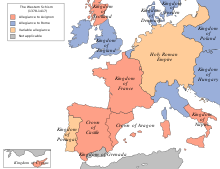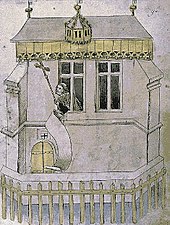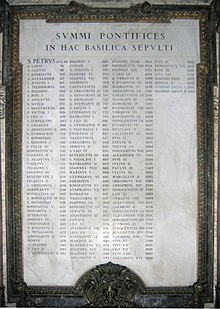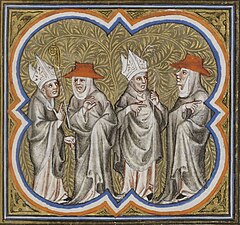|
Western Schism
The Western Schism, also known as the Papal Schism, the Great Occidental Schism, the Schism of 1378, or the Great Schism[1] (Latin: Magnum schisma occidentale, Ecclesiae occidentalis schisma), was a split within the Catholic Church lasting from 20 September 1378 to 11 November 1417, in which bishops residing in Rome and Avignon simultaneously claimed to be the true pope, and were eventually joined by a third line of Pisan claimants in 1409. The event was driven by international rivalries, personalities and political allegiances, with the Avignon Papacy in particular being closely tied to the French monarchy. The papacy had resided in Avignon since 1309, but Pope Gregory XI returned to Rome in 1377. The Catholic Church split in September 1378, when, following Gregory XI's death and Urban VI's subsequent election, a group of French cardinals declared his election invalid and elected Clement VII, who claimed to be the true pope. After several attempts at reconciliation, the Council of Pisa (1409) declared that both rivals were illegitimate and elected a third purported pope. The schism was finally resolved when the Pisan claimant Antipope John XXIII called the Council of Constance (1414–1418). The Council arranged for the renunciation of both Roman pope Gregory XII and Pisan antipope John XXIII. The Avignon antipope Benedict XIII was excommunicated, while Pope Martin V was elected and reigned from Rome. The split is sometimes referred to as the Great Schism, although this term is usually reserved for the East–West Schism of 1054 between the churches remaining in communion with the See of Rome and those remaining with the Eastern Orthodox Church. HistoryUnder pressure from Philip IV of France, the papacy had, since 1309, resided in Avignon, a papal enclave surrounded by France. Initiated by Pope Clement V, the Avignon Papacy had developed a reputation for corruption that estranged much of Western Christendom. This reputation was attributed to perceptions of strong French influence, the papal curia's efforts to extend its powers of patronage, and attempts to increase its revenues. The last Avignon pope, Gregory XI, at the entreaty of relatives, friends, and his retinue, decided to return to Rome on 17 January 1377.[2] Gregory, however, announced his intention to reverse his decision and return to Avignon just after the Easter celebrations of 1378.[3] Before he could return to Avignon, Gregory XI died in the Vatican palace on 27 March 1378.[4] The Romans put into operation a plan to use intimidation and violence (impressio et metus) to ensure the election of a Roman pope.[5] The pope and his curia had returned to Rome after seventy years in Avignon, and the Romans were prepared to do everything in their power to keep them there.[6] On 8 April 1378, the cardinals elected Bartolomeo Prignano, the archbishop of Bari, as Pope Urban VI.[7] Two popes The majority of the cardinals who had elected Urban VI quickly regretted their decision and removed themselves to Anagni.[8] Meeting at Fondi, thirteen cardinals elected Count Robert of Geneva as Pope Clement VII on 20 September 1378.[9] The dissident cardinals argued that the election of Urban VI was invalid because it had been out of fear of the rioting Roman crowds.[10] Unable to maintain himself in Anagni, and following the defeat of his forces at the battle of Marino,[11] Clement VII fled to Naples, which was ruled by one of his supporters, Queen Joanna I of Naples.[12] Despite being met regally by Joanna, Clement was met with the populace chanting, "Viva Papa Urbano" (Long Live Pope Urban) and "Muoia l'Anticristo" (Death to the Antichrist), which convinced him to leave.[12][13] He took a ship to Avignon and reestablished the papal court there. Charles V of France, who seems to have been irked beforehand by the choice of the Roman pontiff, soon became his greatest protector.[14] Besides France, Clement eventually succeeded in winning to his cause Castile, Aragon, Navarre, a great part of the Latin East[where?], and Scotland.[15] Years later, Owain Glyndŵr's rebellion in Wales also recognized the Avignon antipope Benedict XIII.[16] ConsequencesIn the intense partisanship that was characteristic of the Middle Ages, the schism engendered a fanatical hatred noted by Johan Huizinga:[17]
Sustained by such national and factional rivalries, the schism continued after the deaths of both Urban VI in 1389 and Clement VII in 1394. Boniface IX was crowned in Rome in 1389, and Benedict XIII, who was elected against the wishes of Charles VI of France, reigned in Avignon from 1394.[18] When Pope Boniface died in 1404, the eight cardinals of the Roman conclave offered to refrain from electing a new pope if Benedict would resign; but when Benedict's legates refused on his behalf,[a][20] the Roman party then proceeded to elect Pope Innocent VII.[19] Discussions continued instead with Innocent, but quickly stalled and by February 1405, and Benedict's envoys had returned to Avignon.[19] Benedict quickly excommunicated Innocent and with an army started marching towards Rome, in May 1405. He occupied Genoa for a year and awaited French military support, which never came.[19] Innocent died 6 November 1406, and the Roman cardinals elected Angelo Correr as Gregory XII.[21] The suggestion for a church council to resolve the Schism, first made in 1378, was not adopted initially, because canon law required that a pope call a council. Eventually theologians like Pierre d'Ailly and Jean Gerson, adopted arguments that permitted the Church to call a council to resolve this issue,[22] while Francesco Zabarella argued that a council could only be convoked by an emperor.[23] Three popesPope Benedict and Gregory agreed to abdicate their respective papacies in December 1406. However, Benedict stated that he wanted to negotiate a solution first.[21] Gregory sent an ambassador to the St. Victor abbey in Marseille, where Benedict was staying.[21] On the other hand, Gregory preferred Savona, and Benedict concurred.[21] They balked at the last moment, and both groups of cardinals abandoned their preferred leaders.[24] The Council of Pisa met in 1409 under the auspices of the cardinals to try solving the dispute.[24] At the fifteenth session, on 5 June 1409, the Council of Pisa attempted to depose both the Roman pope and Avignon antipope as schismatical, heretical, perjured and scandalous,[25] but proceeded to inflame the problem even further by electing Peter Philargi, the cardinal archbishop of Milan, as Alexander V.[26] He reigned briefly in Pisa from June 26, 1409, to his death in 1410,[27] when he was succeeded by, Baldassare Cossa as John XXIII,[28] who achieved limited support. Council of Constance In 1414, Council of Constance was convened by the Pisan pope John XXIII to resolve the schism once and for all.[29] The council was also endorsed by the Roman pope Gregory XII, giving it greater legitimacy.[30] On 6 April 1415, the council issued Haec sancta, stating that the council is the Church's highest governing body and has the authority to remove popes.[31] Haec sancta is today considered invalid by the Catholic Church, on the basis that Gregory XII was the legitimate pope at the time and the decree was passed by the council in a session before his confirmation; further, since it was not used to remove him, it was not actually used to remove the pope. The council, advised by the theologian Jean Gerson, secured the resignation of Gregory XII and the detention and removal of John XXIII.[32] The Avignon antipope Benedict XIII, who refused to step down, was excommunicated on 27 July 1417, having lost all his supporters in the process.[33][32] The Council elected Pope Martin V in 1417, essentially ending the schism.[34] Benedict XIII, recognized by King Martin of Aragon in 1397, chose to ignore pleas for his resignation.[35] Benedict died 23 May 1423: to succeed him three cardinals elected Gil Sanchez Munoz y Carbon as Clement VIII.[36] Clement VIII resigned in 1429 and recognized Martin V, putting a definite end to the last remnants of the Avignon Papacy.[36] AftermathConciliarism gained impetus due to the Schism.[37] This new reformist movement held that a general council is superior to the pope on the strength of its capability to resolve ecclesiastical issues. Theorists such as Jean Gerson explained that the priests and the church itself are the sources of the papal power and, thus, the church should be able to correct, punish, and, if necessary, depose a pope. On 18 January 1460, Pope Pius II issued the bull Execrabilis which forbids any attempt to appeal papal judgements by general councils.[38] There was also a marked decline in discipline within the church. Scholars note that the Western Schism effectively eroded the church's authority and its capacity to proclaim the gospel.[39] This dissension and loss of unity ultimately culminated in the Protestant Reformation of the 16th century. Official list of popes For the next five centuries, the Catholic Church recognized the Roman popes as the legitimate line from 1378 to 1409, followed by the Pisan popes from 1409 to 1415. All Avignon popes after 1378 are considered to be antipopes. This recognition is reflected in the numbering of popes Alexander VI, VII, and VIII, who numbered themselves consecutively after their Pisan namesake Alexander V. The recognition of the Pisan popes made the continued legitimacy of the Roman pope Gregory XII doubtful for 1409–1415. The Annuario Pontificio for 1860 listed the Pisan popes as true popes from 1409 to 1415, but it acknowledged that Gregory XII's reign ended in either 1409 or 1415. The Western Schism was, in practice, reinterpreted in 1958 when Angelo Giuseppe Roncalli chose to reuse the ordinal XXIII upon his election as Pope John XXIII, citing "twenty-two [sic] Johns of indisputable legitimacy."[40] (There had actually been twenty undisputed Johns due to antipopes and numbering errors.) Although Roncalli's declaration of assuming the name specified that his decision was made "apart from disputes about legitimacy", this passage was subsequently excised from the version appearing in the Acta Apostolicae Sedis, and the Pisan popes Alexander V and John XXIII have since been classified as antipopes by the Roman Curia.[41] The reinterpretation is reflected in modern editions of the Annuario Pontificio, which extend Gregory XII's reign to 1415. The line of Roman popes is now retroactively recognized by the Catholic Church as the sole legitimate line during the Western Schism. However, Popes Alexander VI through VIII have not been renumbered, leaving a gap in the numbering sequence. According to John F. Broderick (1987):
Papal RecognitionNotesReferences
Sources
External links |
||||||||||||||||||
